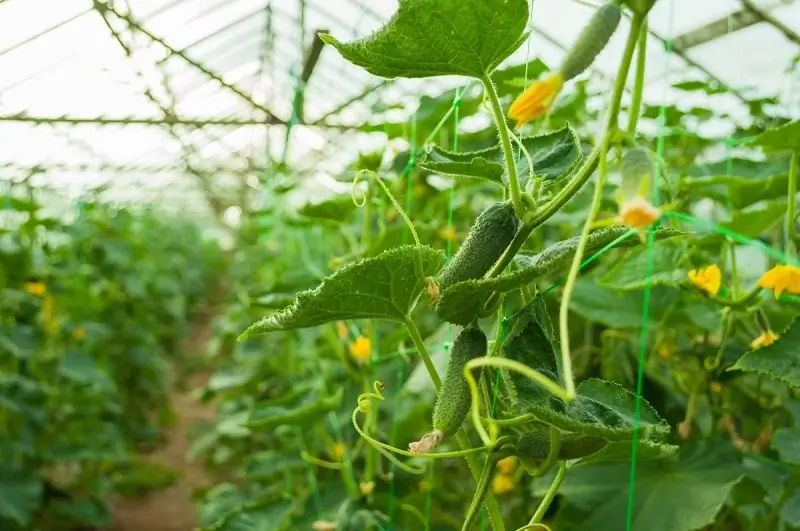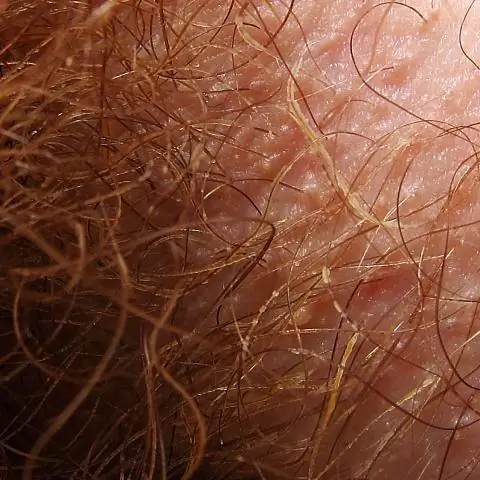
Table of contents:
- Author Bailey Albertson [email protected].
- Public 2023-12-17 12:53.
- Last modified 2025-01-23 12:41.
How to understand by the color of spots on cucumber leaves what plants are sick with

The condition of the leaves is an indicator of the health of cucumbers grown in the beds. The first symptom of morbidity is the deterioration in the appearance of the bush, the appearance of spotting on its foliage. By the type of spots, you can establish what the plant is sick with.
Yellow spots
Yellow spots are a symptom inherent in many diseases affecting vegetable crops. This is how bacteriosis, ordinary mosaic, black leg manifests itself.
Bacteriosis

The incidence of bacteriosis in cucumbers is caused by infection with the bacterium Pseudomonas syringae pv. Lachrymans. Diseased plants can be easily identified by the watery yellow spots that appear on the leaves, covered with a whitish bloom. They tend to grow and darken quickly.
Over time, the white bloom turns into a crust that tears apart the leaf tissue, as a result of which holes are formed. If left untreated, the affected foliage crumbles and the plant withers.
Spots with bacteriosis are present not only on the leaves, but also on the fruits. They look superficial and have a rounded shape. They are also covered with white bloom. The spots gradually rot, causing the fruit to fall off.
Ordinary mosaic

An ordinary mosaic, or mosaic wilting, of cucumbers is called a disease of viral origin. It affects both ground and greenhouse cucumbers. The first symptom of the disease is the appearance on young leaves of light yellow spots-stars. As the leaf plate ages, they swell. The cucumber bush turns completely yellow.
The mosaic virus is dangerous in that it interferes with normal development and fruiting, little ovary is formed. It produces small and ugly fruits that are covered with yellow specks. Under bad weather conditions, the cucumbers affected by the common mosaic quickly wither, and they die.
Blackleg

Blackleg is caused by a fungus. In addition to yellowing of the leaves, there is a change in the color of the root collar. It turns brown and gradually decays. The cucumber seedlings affected by the black leg die en masse. The remaining plants look twisted, underdeveloped, they are not able to give a good harvest.
White spots

The formation of whitish asterisks on the leaves is a symptom of a dangerous viral disease called white mosaic. The greenhouse culture is susceptible to the disease. As it progresses, the entire leaf plate turns white. However, green veins remain clearly visible on its surface.
Defeat with white mosaic is fraught with poor fruiting, such plants give little yield. The fruits are ugly: small, bumpy, with yellowish-white stripes on the surface.
The incidence of powdery mildew in cucumbers, which has a fungal etiology, also leads to the appearance of white spot on the foliage. The disease manifests itself as rounded white spots on the leaf plates. On both sides of the leaf, there is also a whitish coating that resembles flour.
As the disease progresses, the spots grow, merge with each other, and darken. The sheet itself is deformed, begins to bend outward. After that, its dying off is observed.
The disease progresses rapidly. The mottling and white bloom spreads throughout the plant. The diseased bush does not bear fruit well, gives small and bitter cucumbers. If you do not take action, there is a risk of plant death and complete loss of crops.
Brown and brown spots
The appearance of brown or brown spots on the foliage is a symptom of many diseases:
- anthracnose;
- ascochitis;
- downy mildew;
- angular spotting.
Anthracnose

The incidence of anthracnose (copperhead) cucumbers is indicated by the appearance of large reddish spots on the leaves, stems and fruits, reaching a diameter of 4 cm. Gradually, holes form in their place. The plant itself is covered with brown ulcers and stops growing.
Copperhead is a fungal disease, the development of which is promoted by dampness. A diseased bush infects everyone else. The disease spreads with lightning speed from one plant to another.
Ascochitosis

Ascochitis, also called black mycosperellus stem rot, affects mainly greenhouse cucumbers. With this fungal disease, lightening of the edge of the leaf plate is first observed.
The surface is gradually covered with pale spots, which tend to grow, darken and merge with each other. As the disease progresses, all foliage is affected, and brown ulcers form on the stems. The fruits darken, covered with black specks.
The disease does not affect the vascular system of the cucumber bush. For this reason, it does not stop fruiting. However, it is impossible to eat cucumbers that a diseased plant gives. They are covered with ulcers on the outside, and the flesh is subject to decomposition. Lack of treatment threatens the death of the landing.
Downy mildew

A bush affected by peronosporosis (downy mildew) can be identified by the yellow spots that appear on the leaf plates, which darken and turn brown over time. The leaf itself gradually dies off. There is a grayish-purple bloom on it.
Cold and damp weather contributes to the spread of this fungal disease. It affects both ground and greenhouse cucumbers. In the absence of timely and correct treatment, the plants die within 2 weeks.
Angular spotting

Bacteriosis, also called angular spotting, manifests itself at the initial stage as yellow spots. However, as the disease progresses, they increase in size and become dark, and the plant itself becomes covered with ulcers.
Greenhouse cucumbers are especially susceptible to bacteriosis. Promotes the development of heat and dampness disease. It often appears due to improper watering. The fruits are not suitable for human consumption.
Recommended:
How To Remove Yellow Spots From Underarm Sweat On Clothes (white And Other Colors), How To Remove Traces Of Deodorant + Photos And Videos

How to remove yellow sweat and deodorant marks from underarms. Different ways to help remove or remove underarm stains on clothes made from different fabrics
How To Feed Cucumbers In The Open Field If The Leaves Turn Yellow And In Other Cases

Top dressing with slow growth of cucumbers. How to fertilize if the leaves turn yellow. How to feed in a polycarbonate greenhouse. Feeding with yeast. Instructions. Video
How To Plant And Grow Cucumbers In The Open Field: Plant Seeds, Properly Care For Plants (water, Form, Tie Up)

What varieties and hybrids of cucumbers can be grown in the open field. Features of planting seeds and seedlings. Choice of place and timing. The nuances of care and formation
Is It Possible To Pray For Animals That Are Sick Or Dead In Orthodoxy

Is it possible to pray for animals, sick or dead. The opinion of the Russian Orthodox Church on prayers for pets
Why You Can't Wear Lenses When You're Sick

Why you can't wear lenses for diseases that are accompanied by fever. For what diseases should the eyes rest
